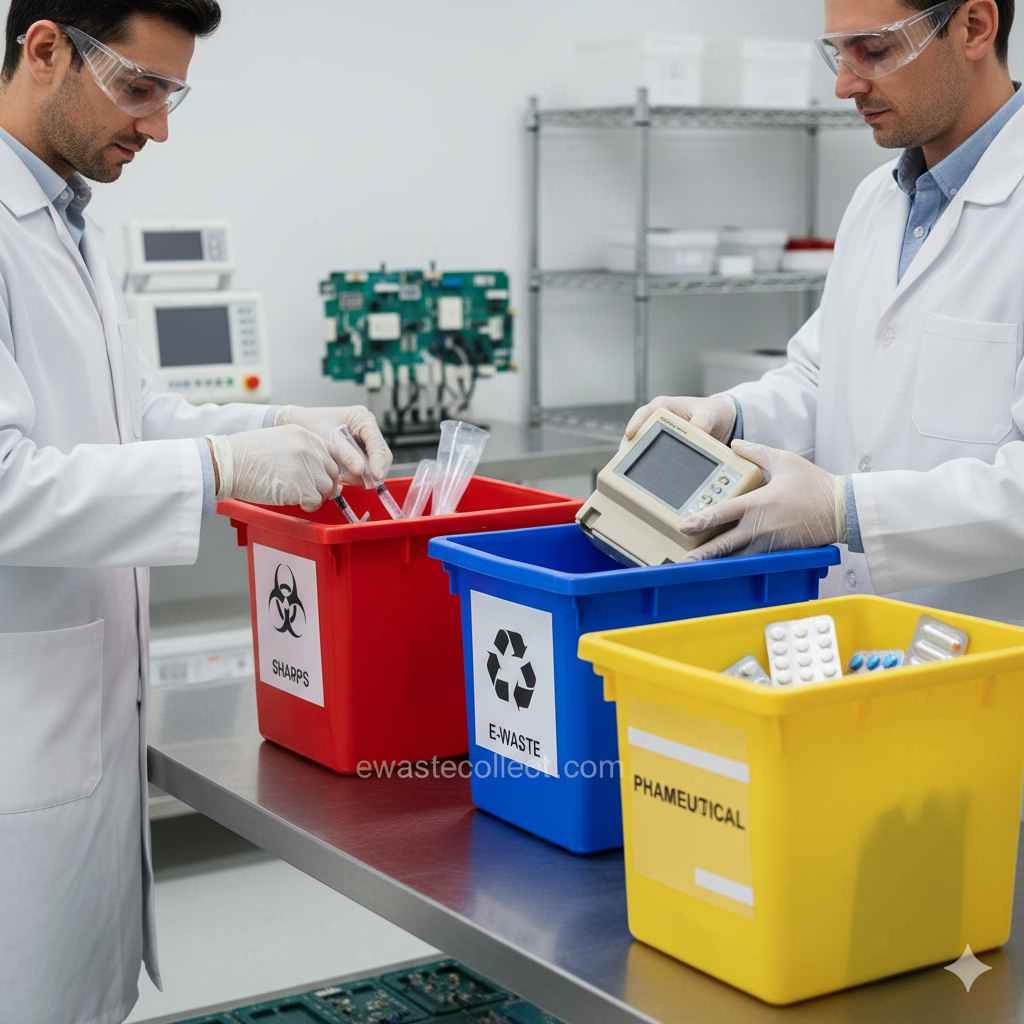Contents
ToggleMedical Equipment Disposal Australia | Complete 2025 Guide
If you’re searching for medical equipment disposal Australia that is safe, legal and genuinely sustainable, this guide is for you. From hospitals and clinics to aged-care and home users, we’ve distilled the current best-practice for disposing and recycling devices without risking fines, data breaches, or environmental harm—backed by practical steps you can implement today.

What Counts as Medical Equipment in Australia?
Understanding categories helps you route items correctly and reduce risk. Typical streams include:
- Durable clinical devices — patient monitors, defibrillators, infusion pumps, ventilators.
- Imaging & diagnostic — X-ray, MRI, ultrasound, ECG, lab analyzers and microscopes.
- Furniture & non-electronic assets — hospital beds, trolleys, IV stands, commodes.
- Home healthcare — nebulizers, CPAP, glucometers, blood pressure monitors.
- Consumables & sharps clinical waste — syringes, blades, soiled PPE (special handling only).
Why Proper Disposal & Recycling Matters
Environmental protection
- Electronics may contain lead, mercury, cadmium and lithium cells—landfill or poor storage can contaminate soil & water.
- Recycling recovers copper, aluminium and precious metals, reducing demand for virgin mining.
Human health & safety
- Sharps and infectious items require licensed clinical waste pathways to prevent injuries & disease transmission.
- Chemical residues and pharmaceuticals need controlled collection to avoid exposure.
Privacy & compliance
- Many devices store patient data (PHI). Secure erasure or physical destruction is mandatory before resale or recycling.
Learn more from Australian regulators: EPA Victoria, NSW Health, OAIC Privacy Act 1988, Safe Work Australia.
Medical Equipment Disposal Australia: 10 Proven, Safe & Legal Steps
1) Audit & classify your items
Tag devices by stream: clinical waste, e-waste, non-electronic assets, chemicals/pharmaceuticals. Correct classification prevents costly mistakes.
2) Decontaminate before handling
Clean and disinfect per facility infection-control procedures. Items with biohazard risk go via licensed clinical waste contractors—never general recycling.
3) Protect staff with WHS controls
Use PPE, sharps containers, trolleys and lockable cages. Train teams to segregate at source and label clearly.
4) Secure data destruction for smart devices
For anything that may store PHI (e.g., imaging consoles, monitors with storage), use certified wipe tools or physical media destruction and record certificates.
5) Reuse & refurbishment first (where lawful)
Non-critical equipment in good condition can be refurbished for secondary use or donation—only after full decontamination, safety testing and documentation.
6) Choose accredited medical e-waste recycling
Send electronics to certified recyclers who dismantle, recover metals, and treat hazardous fractions safely. Ask for downstream transparency.
7) Handle pharmaceuticals & chemicals separately
Use sealed containers and specific manifests for transport. Never mix with general e-waste or landfill streams.
8) Maintain auditable records
Keep disposal certificates, chain-of-custody, serial/asset lists, data-wipe reports and contractor licenses for audits and tenders.
9) Optimise logistics for large assets
Book deinstallation, electrical isolation and crane/rigging where required (e.g., X-ray, MRI). Plan routes to reduce downtime and site risk.
10) Review policy annually
Update your medical equipment disposal program to reflect legislation, new device types and incident learnings; retrain staff at least yearly.
What Cannot Go Through Standard Recycling in Australia
- Used sharps and contaminated PPE (licensed clinical waste only).
- Pathological waste (specialist biohazard streams).
- Pharmaceuticals and cytotoxic residues (controlled destruction).
For detailed coverage of collection areas and services, see our Medical Equipment Recycling Services in Australia and our quick Booking Options (Pickup / Deinstallation).
Where We Operate
EwasteCollect supports hospitals, clinics, dental and lab sites across Sydney, Melbourne, Brisbane, Perth, Adelaide and regional Australia with secure pickup, deinstallation and compliant recycling.
Home Users: Small-Scale Medical Equipment Disposal in Australia
- Use pharmacy or council programs for sharps; never place needles in household bins.
- Return expired medicines via approved take-back points—don’t flush or bin.
- Take electronic devices (CPAP, meters) to e-waste drop-off or book a pickup.
- Remove personal data from any connected device when possible.
Compliance Snapshot for Australia
- Environmental protection: Follow state EPA requirements (licensing, manifests, transport tracking, storage).
- Privacy: The Privacy Act 1988 drives data-destruction obligations on devices storing PHI.
- WHS: Risk assessments, PPE, sharps handling training, and incident reporting.
Book a Compliant Pickup or Deinstallation
Need fast, certified medical equipment disposal Australia? Our technicians handle decontamination, data destruction, removal and recycling — with full documentation.
FAQ: Medical Equipment Disposal Australia
What devices can be recycled?
Most non-contaminated electronics—monitors, pumps, ventilators, diagnostic and lab equipment—are recyclable through certified e-waste programs.
Can I recycle used syringes or soiled PPE?
No. These are clinical waste and must be handled by licensed providers using approved sharps containers and transport.
How do you handle patient data?
Devices are wiped with certified tools or storage is destroyed; certificates are issued for audit and privacy compliance.
Do you cover regional areas?
Yes. We schedule combined routes for regional pickups. Contact us for minimum volumes and timeframes.
In Summary
With the right partner, medical equipment disposal Australia can be safe, compliant and genuinely sustainable. EwasteCollect provides audited data destruction, certified deinstallation, secure transport and transparent recycling—end-to-end. Book a pickup today and keep your facility audit-ready while protecting people and planet.
